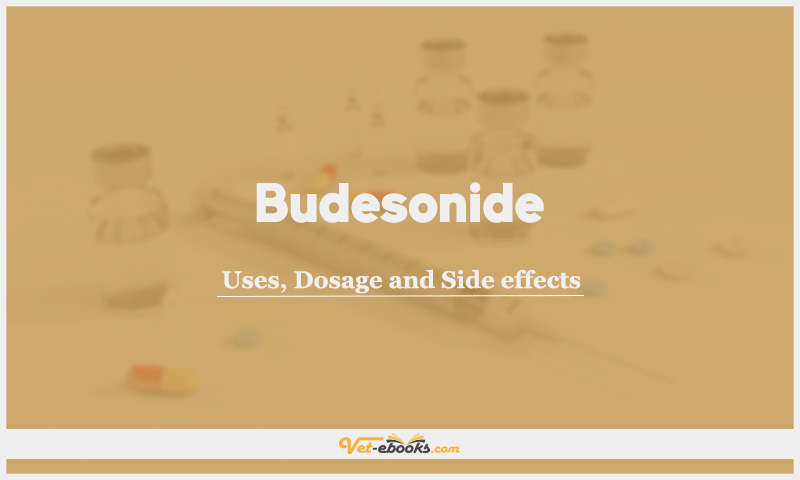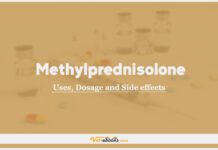Budesonide: Uses, Dosage and Side Effects

Overview
Budesonide is a potent glucocorticoid, about 15 times stronger than prednisolone,
with strong topical anti-inflammatory activity and minimal mineralocorticoid activity.
Enteric-coated formulations delay dissolution until the duodenum, allowing the drug
to act directly on intestinal tissue.
Although budesonide is absorbed from the gut, it undergoes significant first-pass metabolism
in the liver, which lowers systemic glucocorticoid effects. Despite this, HPA axis suppression
has been observed in dogs, cats, and horses.
Uses of Budesonide
In dogs
-
In dogs with chronic inflammatory enteropathies, commercial
budesonide capsules led to modest clinical or histologic improvement, while
placebo-treated dogs showed disease progression.
In cats
- Anecdotally, budesonide may be helpful in some cats with chronic inflammatory enteropathies.
- Inhaled budesonide has improved signs of asthma and chronic bronchitis.
In horses
-
It significantly improved pulmonary function in severe equine asthma (SEA),
formerly known as recurrent airway obstruction (RAO).
Dose of Budesonide
- DOGS
Adjunctive treatment of chronic inflammatory enteropathies:
- 1 mg (must be compounded) for body weight 3 to 7 kg, PO once daily.
- 2 mg (must be compounded) for 7.1 to 15 kg, PO once daily.
- 3 mg (commercially available) for 15.1 to 30 kg, PO once daily.
- 5 mg (must be compounded) for greater than 30 kg, PO once daily.
- Once adequately controlled, gradual reductions in dosage amounts or frequency (every other day) are desirable.
2. CATS:
Adjunctive treatment of chronic inflammatory enteropathies:
- Most cats tolerate oral glucocorticoids, but in those that cannot and especially in diabetic cats, budesonide can be considered.
- 0.5 – 0.75 mg/cat PO once daily.
- NOTE: These dosages require reformulation to provide the appropriate dose.
3. HORSES
Adjunctive treatment of severe equine asthma:
- 1.8 mg total dose twice daily.
- The drug was delivered as 8 actuations via Respimat® inhalation device and using an equine-specific nostril adapter.
Popular Dosage Forms
- No veterinary-labeled budesonide products are currently available.
-
The Association of Racing Commissioners International (ARCI) classifies budesonide as a
Class 4 substance. -
Human-labeled budesonide products include extended-release capsules (3 mg and 9 mg, micronized),
available under brand names such as Entocort EC®, Uceris®, and as
generics (prescription only).
Drug Dosage Calculator
You Should Give:
Precautions
-
Budesonide may cause systemic corticosteroid effects, so it should be used
with caution in patients where glucocorticoid use is risky. -
Conditions of concern include gastrointestinal ulcers,
active infections, diabetes mellitus, and cataracts. -
Patients with hepatic impairment may be at higher risk for systemic effects,
and dosage reduction may be necessary. -
Because budesonide suppresses the HPA axis, exogenous steroids should
be considered during stressful procedures, such as surgery.
Drug Interactions
-
Aspirin increases the risk of gastrointestinal erosion, ulceration, or perforation
when used with budesonide. -
NSAIDs (e.g., carprofen, meloxicam, robenacoxib) also increase the risk for
GI complications when combined with budesonide. -
Oral antacids may interfere with budesonide’s pH-dependent coating;
administer budesonide at least 2 hours apart from oral antacids. -
Other acid-reducing drugs (e.g., famotidine, omeprazole)
do not significantly affect budesonide’s pharmacokinetics. -
Budesonide is extensively metabolized by the CYP3A enzyme;
drugs that inhibit CYP3A can significantly increase systemic exposure. -
Azole antifungals (e.g., fluconazole, itraconazole, ketoconazole),
especially ketoconazole, can increase budesonide AUC by up to 8-fold.
Contraindications of Budesonide
- Budesonide is contraindicated in patients hypersensitive to it.
Side Effects of Budesonide
-
It has been demonstrated that compounded budesonide powder and commercial formulations
significantly reduce the HPA axis in dogs. -
Budesonide can cause GI erosion, ulceration, or perforation
if taken in excess because it is a strong glucocorticoid with local GI activity. -
It has been demonstrated that inhaled budesonide lowers cortisol levels in horses
and suppresses the HPA axis in cats.
Overdose
- Budesonide doses of 200 mg/kg were fatal to mice.
-
Although glucocorticoid overdoses by themselves are usually not likely to result in significant injury,
dogs may experience severe gastrointestinal symptoms. - As needed, supportive treatment should be given if clinical symptoms appear.
Some Notes:
- Up to 80 µg/kg of budesonide administered subcutaneously did not affect rat fertility.
-
It has been demonstrated to be teratogenic and embryocidal in rats and rabbits,
just like other corticosteroids. -
Budesonide should only be administered when the benefit to the mother surpasses
the possible risk to the fetus, as safety in veterinary species has not been proven.
Do You Want To Increase Your Veterinary Knowledge and Practical Skills?
You Can Now Browse and Download +3000 Books For Veterinary Professionals & Students Online.
Download Veterinary Books





























